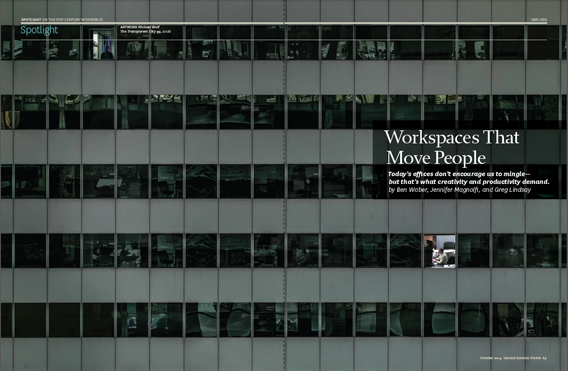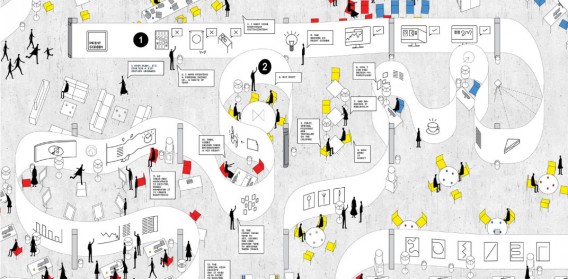














September 09, 2014 | permalink

“Workspaces That Move People” is my new story in the October issue of Harvard Business Review. Written with Ben Waber and Jennifer Magnolfi, together we make the case that we are finally – finally – able to prove that: a) where and how you work define who you work with; b) who you work with drives group performance to a large extent, and c) we can finally start to map workspace performance metrics to organizational ones.
In a nutshell, it means we’re this close to finally designing (and then constantly redesigning) workspaces that actually help you do your job, rather than struggling against them. The key is deploying a new generation of sensors – in our phones, in our offices, or even worn around your neck (or your wrist) – that can collect the necessary breadth and depth of data. With that in hand, we can start to understand who we should really be working with, where, and why – a milestone that means the end of the office as we know it.
I had the pleasure of writing about Ben’s work in The New York Times and Jennifer’s work in Fast Company last year. I’ve been searching for ways to connect the pair’s ideas, and it was AMO’s Daniel Pittman who suggested we join forces and write an article about it. As with most of my recent work, this piece tries to tease out the implications of how real-time data and social network analysis will map onto physical space. What if you shouldn’t be working with your nominal colleagues, but with different teams at different offices – or even at different companies? Knowledge work has been confined to the office nearly a century; but now we have the means to disperse organizations across cities (which I hope will be as good for the cities in question as for the organizations).
The beginning of the piece is below; ready the entire thing at HBR.org.
*
In Silicon Valley, the tight correlation between personal interactions, performance, and innovation is an article of faith, and innovators are building cathedrals reflecting this. Google’s new campus is designed to maximize chance encounters. Facebook will soon put several thousand of its employees into a single mile-long room. Yahoo notoriously revoked mobile work privileges because, as the chief of human resources explained, “some of the best decisions and insights come from hallway and cafeteria discussions.” And Samsung recently unveiled plans for a new U.S. headquarters, designed in stark contrast to its traditionally hierarchical culture. Vast outdoor areas sandwiched between floors will lure workers into public spaces, where Samsung’s executives hope that engineers and salespeople will actually mingle. “The most creative ideas aren’t going to come while sitting in front of your monitor,” says Scott Birnbaum, a vice president of Samsung Semiconductor. The new building “is really designed to spark not just collaboration but that innovation you see when people collide.”
Faith is nice, but do executives have proof that this works? Social space like Samsung’s could be just another in a long line of fads and broken promises in workspace design: The “action office” becomes the cubicle. Cubicles are torn down for open plans, which leave introverts pining for private space. Quads. Hotel space. Couches. Rotating desk assignments. Standing desks. Treadmill desks. No desks. With apologies to Mark Twain, there’s no such thing as a new office design. We just take old ideas, put them into a kind of kaleidoscope, and turn. How do we know whether any of these approaches is effective? The key metric companies use to measure space–cost per square foot–is focused on efficiency. Few companies measure whether a space’s design helps or hurts performance, but they should. They have the means. The same sensors, activity trackers, smartphones, and social networks that they eagerly foist on customers to reveal their habits and behavior can be turned inward, on employees in their work environments, to learn whether it’s true that getting engineers and salespeople talking actually works.
We’ve already begun to collect this kind of performance data using a variety of tools, from simple network analytics to sociometric badges that capture interaction, communication, and location information. After deploying thousands of badges in workplaces ranging from pharmaceuticals, finance, and software companies to hospitals, we’ve begun to unlock the secrets of good office design in terms of density, proximity of people, and social nature. We’ve learned, for example, that face-to-face interactions are by far the most important activity in an office. Birnbaum is on to something when he talks about getting employees to “collide,” because our data suggest that creating collisions – chance encounters and unplanned interactions between knowledge workers, both inside and outside the organization – improves performance.
We’ve also learned that spaces can even be designed to produce specific performance outcomes – productivity in one space, say, and increased innovation in another, or both in the same space but at different times. By combining the emerging data with organizational metrics such as total sales or number of new-product launches, we can demonstrate a workspace’s effect on the bottom line and then engineer the space to improve it. This will lead to profound changes in how we build our future workspaces. Here are a few:
Recognize office space as not just an amortized asset but a strategic tool for growth. The consulting and design firm Strategy Plus estimates that office utilization peaks at 42% on any given day. By that logic, the best way to manage cost per square foot is to remove “wasted” square feet. But the data we’re generating reveal that investments in re-engineering space for interactions over efficiency can increase sales or new-product launches.
Design offices to reflect how 21st-century digital work actually happens. The buildings we go to every day haven’t changed as much as have the tools we use to get work done. Merging digital communication patterns with physical space can increase the probability of interactions that lead to innovation and productivity.
Re-engineer offices to weave a building, a collection of buildings, or a variety of workspaces into the urban fabric. The office of the future will most likely include highly networked, shared, multipurpose spaces that redefine boundaries between companies and improve everyone’s performance.
Getting there won’t be easy. It will require collecting much more data to inform new design and management principles while engaging urban planners and municipal governments. It will also transform HR, IT, and facilities management from support functions to facilitators. But if companies can change their spaces to refl ect how people work, performance improvement will follow. Don’t take that on faith. There are data to prove it….
August 31, 2014 | permalink
Three years ago, filmmaker Marc Lafia interviewed me for his documentary-in-progress, Revolution of the Present. At long last, the final cut has arrived (and embedded above for your viewing pleasure). What’s it all about? I’ll let Marc explain:
The hope was that network technology would bring us together, create a “global village,” make our political desires more coherent. But what’s happened is that our desires have become distributed, exploded into images and over screens our eyes relentlessly drop to view.
REVOLUTION OF THE PRESENT examines the strange effects – on cities, economies, people – of what we might call accelerated capitalism. Set against a visually striking array of sounds and images, 15 international thinkers speak to the complexity and oddity of this contemporary moment as they discuss what is and what can be.
Humanity seems to be stuck in the perpetual now that is our networked world. More countries are witnessing people taking to the streets in search of answers. Revolution of the Present, the film, features interviews with thought leaders designed to give meaning to our present and precarious condition. This historic journey allows us to us re-think our presumptions and narratives about the individual and society, the local and global, our politics and technology. This documentary analyzes why the opportunity to augment the scope of human action has become so atomized and diminished. Revolution of the Present is an invitation to join the conversation and help contribute to our collective understanding.
As Saskia Sassen, the renowned sociologist, states at the outset of the film, ‘we live in a time of unsettlement, so much so that we are even questioning the notion of the global, which is healthy.’ One could say that our film raises more questions than it answers, but this is our goal. Asking the right questions and going back to beginnings may be the very thing we need to do to understand the present, and to move forward from it with a healthy skepticism.
Revolution of the Present is structured as an engaging dinner conversation, there is no narrator telling you what to think, it is not a film of fear of the end time or accusation, it is an invitation to sit at the table and join an in depth conversation about our diverse and plural world.
If this film is a dinner conversation, then I’m the guest who’s had too much to drink. I hope you’ll stay for dessert.
August 23, 2014 | permalink

(image ® ennead architects)
One of the perks of writing Aerotropolis was being asked by André Balazs in June 2011 to help him reinvent the airport hotel. The site was Eero Saarinen’s semi-abandoned TWA Flight Center at New York JFK, the last cathedral of the Jet Age. My role as a consultant was minor to say the least, but I was still sad to see the deal with the Port Authority of NY/NJ fall apart – understandably so, given the financial difficulties of making an airport Standard work. I thought our plans would never see the light of day, but ennead architects has gone ahead and posted their renderings of the site. Please click through, and enjoy a glimpse of the coolest airport hotel that never was.
August 20, 2014 | permalink
The Aspen Institute has posted an abbreviated clip from one of my sessions at this year’s Ideas Festival, “Smart City Limits: How Much Can Big Data Really Do?” I was fortunate to have Code for America’s Jen Pahlka, IBM’s Guru Banavar, and the Santa Fe Institute’s LuÃs Bettancourt discuss the limits of technology and theoretical models when it comes to improving the quality of life in cities. Enjoy.
August 13, 2014 | permalink

The Van Alen Institute has partnered with the New Orleans Redevelopment Authority (NORA) to launch “Future Ground,” a competition to make New Orleans a global leader in reusing vacant land. I’m honored to have been asked to join Adrian Benepe, Toni Griffin, Mitchell Silver, and Stephen Zacks, among many others, to serve on the competition’s advisory board. “Future Ground” will generate flexible design and policy strategies that forecast and accommodate changes in density, demand, climate, and landscape over the next half-century in New Orleans, transforming abandoned landscapes into resources for the current and future city.
Three teams will be selected to participate in a six-month research and design process to tackle the social, economic, and ecological challenges underlying reuse of the most prevalent types of vacant land in the city. Working closely with local stakeholders and national experts, teams will produce implementable, replicable solutions that can be applied to specific sites citywide, and that can help catalyze change in cities around the world.
For more information on how to apply, please visit http://www.vanalen.org/projects/competitions/FutureGround
July 21, 2014 | permalink
There’s a short – barely a minute’s worth – of video highlights from my talk at the launch of Amsterdam’s Institute of Advanced Metropolitan Solutions last month. I appear around the 5:20 mark and speak until 6:20. The magic of jet lag and editing has slowed my speech patterns to the point where it’s actually comprehensible. Enjoy.
July 16, 2014 | permalink

Architizer has posted a brief story on the Space Forward Ideas Competition, in which my entry with Katrina Szabo, “Serendipity Engine,” was a runner-up.
The winning entry, “Print Screen,” imagines a programmable office in which workers print soundproof screens to shape their environment more or less on the fly. As for our project, “an app called Serendipity Engine combines tracking data and real space to promote social engagement and collaboration, not unlike smart-home products such as Nest and DARPA projects like Squad X.”
July 16, 2014 | permalink

(Originally published at Next City on July 14, 2014.)
If you doubt the world is really comprised of a network of cities – rather than that increasingly creaky construct, the nation-state – look no further than time-lapse photography of global air routes. One can spot the glowing economic cores of Western European, Northeast Asia and the Eastern Seaboard at a glance.
But the strength of those ties is changing. Boeing released its latest 20-year forecast for aviation last week, and it predicts the number of airline passengers will double in the next two decades. The surge in new travelers will produce demand for 36,770 new planes worth $5.2 trillion, and Boeing expects the vast majority of those planes (more than 25,000) will be of the single-aisle variety – preferably a successor to the Boeing 737, as ubiquitous and utilitarian as a city bus. Most of these new customers will be airlines in Asia, as rising incomes in the continent’s emerging middle class propel waves of Chinese, Indian and Indonesian tourists to Phuket and Hainan just as the original 737s ferried Americans to Orlando and Las Vegas.
Such numbers might sound absurd to Westerners – how could there be twice as many passengers in a mere 20 years? But globally, air traffic has already nearly doubled in just the last decade. What’s more, the largest deals in the history of Airbus and Boeing – for 234 aircraft in 2013 worth $24 billion at list prices, and for 230 jets in 2011 worth $22.4 billion, respectively – were both made with an airline most Americans have never even heard of: Indonesia’s Lion Air. “There are three billion people in Asia, there are 300 million people in America. America has about three times more planes right now than Asia,” AirAsia founder Tony Fernandes told Bloomberg Television last year.
July 10, 2014 | permalink

One of the highlights of attending the Clinton Global Initiative America this year was posing with “the Secretary,” as she’s called, as a reward for making a commitment to action. I didn’t have a “me wall” before, but I guess I just started one.
July 10, 2014 | permalink
Aspen Public Radio has a brief interview with me taped before last month’s Aspen Ideas Festival, but didn’t hit the Web until today. (I guess there was a backlog of thought leaders.) I talked about the usual suspects – cities, serendipity, transportation, and more. The audio is above.

» Folllow me on Twitter.
» Email me.
» See upcoming events.

Greg Lindsay is a generalist, urbanist, futurist, and speaker. He is a non-resident senior fellow of the Arizona State University Threatcasting Lab, a non-resident senior fellow of MIT’s Future Urban Collectives Lab, and a non-resident senior fellow of the Atlantic Council’s Scowcroft Strategy Initiative. He was the founding chief communications officer of Climate Alpha and remains a senior advisor. Previously, he was an urban tech fellow at Cornell Tech’s Jacobs Institute, where he explored the implications of AI and augmented reality at urban scale.

----- | January 22, 2024
The Future of Generative AI in Architecture, Engineering, and Construction
----- | January 1, 2024
----- | August 3, 2023
CityLab | June 12, 2023
Augmented Reality Is Coming for Cities
CityLab | April 25, 2023
The Line Is Blurring Between Remote Workers and Tourists
CityLab | December 7, 2021
The Dark Side of 15-Minute Grocery Delivery
Fast Company | June 2021
Why the Great Lakes need to be the center of our climate strategy
Fast Company | March 2020
How to design a smart city that’s built on empowerment–not corporate surveillance
URBAN-X | December 2019
CityLab | December 10, 2018
The State of Play: Connected Mobility in San Francisco, Boston, and Detroit
Harvard Business Review | September 24, 2018
Why Companies Are Creating Their Own Coworking Spaces
CityLab | July 2018
The State of Play: Connected Mobility + U.S. Cities
Medium | May 1, 2017
Fast Company | January 19, 2017
The Collaboration Software That’s Rejuvenating The Young Global Leaders Of Davos
The Guardian | January 13, 2017
What If Uber Kills Public Transport Instead of Cars
Backchannel | January 4, 2017
The Office of the Future Is… an Office
New Cities Foundation | October 2016
Now Arriving: A Connected Mobility Roadmap for Public Transport
Inc. | October 2016
Why Every Business Should Start in a Co-Working Space
Popular Mechanics | May 11, 2016
Can the World’s Worst Traffic Problem Be Solved?
The New Republic | January/February 2016

January 31, 2024
Unfrozen: Domo Arigatou, “Mike 2.0”
January 22, 2024
The Future of Generative AI in Architecture, Engineering, and Construction
January 18, 2024
The Promise and Perils of the Augmented City
January 13, 2024